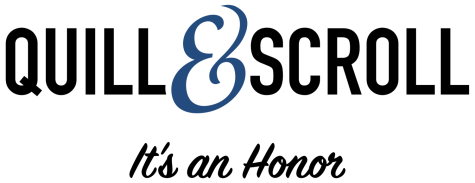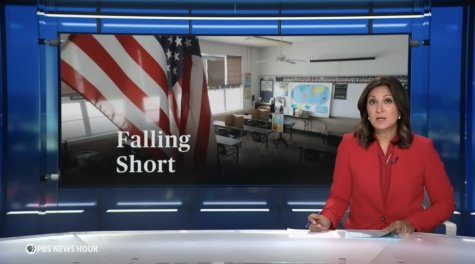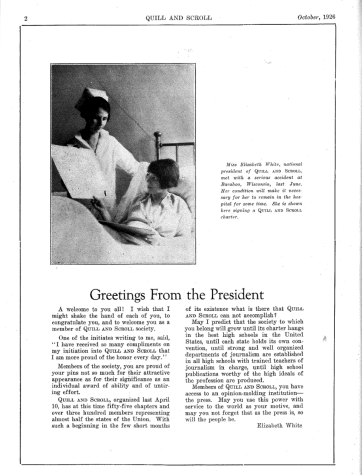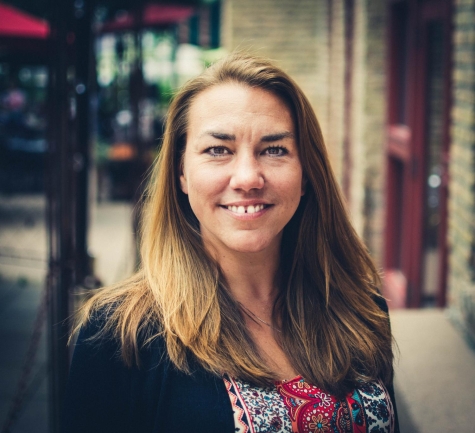Sept. 29, 2025
Our past three editions
Sept. 22, 2025 First Amendment threats • Ticketmaster • WNBA playoffs
Sept. 15, 2025 Traumatic news • Heat waves • Emmys
Sept. 8, 2025 Cell phones in school • AI • “The Summer I Turned Pretty”
THE LEAD
Potential government shutdown looms with plans for mass firings
Cover local effects of federal government funding running out
Federal funding could run out Tuesday Sept. 30, if Congress does not pass legislation to keep the federal government open, Reuters reported. In a memo Sept. 24, the Trump administration threatened to permanently remove workers from some agencies if the shutdown occurs.
The Office of Management and Budget asked agencies to identify programs, projects and activities that will be affected if funding runs out. The memo indicated that once funding is reinstated, agencies should plan to keep the smallest number of employees needed, the Washington Post reported.
At the time of publication, no legislation had been passed to keep the government open.
What you can do—
Though a government shutdown might feel far removed from your community, there may be some local effects you can cover. All nonessential federal employees would be placed on unpaid furlough. National parks and museums would close — are there sites near you that would be affected? CBS News reported some of the potential impacts for Minnesotans near the last government shutdown in March, take a look at this story to help you brainstorm.
Noteworthy
Declines in reading, math scores impact workforce
Take a look at your school’s state testing results
High school seniors’ reading scores are the lowest they’ve been since 1992, according to the results of the National Assessment of Education Progress released earlier this fall. Math scores also fell to the lowest level since 2005.
Fundamental reading and math skills are essential for a wide range of jobs, the New York Times reported, and some jobs screen for basic skills that some students may not possess. Some colleges are offering fundamental classes alongside college-credit courses.
What you can do —
Though standardized test scores are not the only measure of academic success, they are used at a state and national level to inform policy and funding. Take a look at test scores in your area and see how they compare to the rest of the state and nation.
The scores released earlier this month are the first to be released since COVID-19 — take a look at the data available to you and see what effect COVID-19 seemed to have on scores. It would also be interesting to poll how seriously students take tests. Can students opt out? What is the impact on score when they do?
What’s viral
Three missions launch to point 1 million miles away in space to study heliosphere
Write about potential effects of space weather
Last Wednesday, three missions launched aboard a SpaceX rocket from NASA’s Kennedy Space Center in Florida. The three missions, two from NASA and one from the National Oceanic and Atmospheric Administration, will be studying the enormous bubble created by the sun’s charged particles that surrounds earth. This bubble, called the heliosphere, protects earth from cosmic radiation, CNN reported.
One of the missions, the Interstellar Mapping and Acceleration Probe, is made up of 10 instruments that will investigate how solar wind interacts with interstellar space. Past missions, including the Voyager probes, have collected data explaining some of the mysteries about the heliosphere, but this mission will fill in holes.
The second mission catching a ride on this launch is NASA’s Carruthers Geocorona Observatory. The observatory is charged with characterizing and studying the faint ultraviolet glow that emanates from earth’s exposphere, also known as the geocorona.
The final mission, NOAA’s Space Weather Follow On-Lagrange 1, will monitor for sun activity and measure solar wind — actings as a sort of early detection system for solar activity.
What you can do —
If you have a reporter interested in science stories, this is a nice news hook into an interesting topic. The three missions will provide continuous space weather data to NOAA’s Space Weather Prediction Center and expand our understanding of earth’s protection from space weather.
Space weather, including solar flares and coronal mass ejections, can block radio communication, cause electrical failure and degrade power grids. Talk to scientists about what an increased understanding of the heliosphere means for the future of infrastructure here on earth.
The spacecraft won’t reach its destination, Lagrange point 1, until January, providing another news peg. Lagrange point 1 is a special point in space where the gravitational pull from earth is balanced out by the force from the sun. This means spacecraft can stay in this spot using less fuel.
100 years of Quill & Scroll
Meet the Society’s first president
Quill and Scroll’s first president, back in 1926, was Elizabeth White, from Central High School in Nebraska. In the October 1926 edition of the Society’s magazine, she welcomed members to the new organization and expressed her dreams for the future.
“Members of Quill and Scroll, you have access to an opinion-molding institution — the press. May you use this power with service to the world as your motive, and may you not forget that as the press is, so will the people be,” she wrote.
The magazine also features a photo of White in the hospital after a serious accident in Wisconsin. She is shown signing a new charter from her hospital bed.
IT’S AN HONOR
It’s always membership season
Don’t forget you can nominate members year round
Do you have a senior who just met the GPA requirement or a student who now wants to join Quill and Scroll? Want to avoid the spring rush? Nominate students for membership order pins, cords and other Quill and Scroll materials and memorabilia.
We haven’t changed the ordering process from last year. For those wanting to ditch the paper version, you just need to select the form based on how you would like to pay. We have one version for credit card and another version for check or purchase order. (We’ve added buttons for ease of finding these.) As usual, credit card payments are charged $4.49 per order for processing.
Submit your YEC entries today
Contest closes Wednesday, so submit today
The 2025 Yearbook Excellence Contest is open for entries. The cost for each entry in all 39 categories is $8, and schools will be divided by size — Class A for 1,000 or more students, and Class B for 999 or fewer students.
Entry deadline is Oct. 1, and here is a link to complete descriptions of those 39 categories and how to pay for the entries. Please note, we added six categories last year — including three for beginning students and three for middle schoolers.
Judges will award first, second and third places in each category for each class, and they’ll award honorable mentions so that between 10 and 15 percent of all entries are recognized in every category. All students named as award recipients will be eligible to apply for Quill and Scroll student scholarships in May of their senior year.
Quill and Scroll administrators will then tally points (5 for first place, 4 for second, 3 for third and 1 for HM) to determine a Blue and Gold Award winner for each class. Last year’s overall winners were Wando High School of Mount Pleasant, South Carolina and Shawnee Mission South High School of Overland Park, Kansas (Class A) and Christ Presbyterian Academy of Nashville, Tennessee (Class B) have won the overall Blue and Gold Awards in the 2024 Quill and Scroll Yearbook Excellence Contest.
Here’s a complete list of last year’s winners.
Special thanks to our sponsors this year: Picaboo, Varsity and Walsworth. We couldn’t run this program without them.

Take advantage of our advisers-only resource area
Quill and Scroll has expanded its advisers-only area, which includes bellringers and lesson plans for advisers who have initiated members within the past school year. We will be highlighting a helpful resource in each Weekly and Month Scroll.
Advisers, if you inducted members in the 2024-25 or the 2025-26 school year, check your email (and your spam!) for a message from [email protected]. That email should contain your login information. Please be sure to accept cookies when you log in! If you have trouble, you can contact us at [email protected]. If you have inducted members this school year, we update access every few weeks, so keep an eye on your email.
We will be highlighting specific content from the advisers-only area in each Monthly Scroll, so keep reading for some ideas.
Advisers-only resource area highlight
How to include a journalism experience in college essay
This exercise will take those in need of a college essay through the process. It asks students to process their experiences as high school journalists and use it to show who they are for a college or scholarship essay.
National High School Journalism Convention travels to Nashville
This fall the nation’s largest gathering of high school journalists, advisers and journalism teachers will be Nov. 13-16 at the Gaylord Opryland Resort & Convention Center.

The JEA/NSPA National High School Journalism Convention offers hundreds of instructional sessions, keynote speakers from national newsmakers, dozens of media critiques, JEA’s popular on-site media contests and the announcement of the NSPA Broadcast and Newspaper/Newsmagazine and Specialty Magazine Pacemakers. The winners in the NSPA Individual Awards will also be announced.
NSPA also offers a convention Best of Show competition that celebrates current student media from the current school year. The deadline for submitting Individual Achievement entries is Oct. 29. Staff Achievement entries are due at the convention on Nov. 14.
Registration is open now. The early bird discount ends Oct. 3 and online registration will close Oct. 24.
School of the New York Times Summer Academy opportunity
We know it’s early, but for those looking for a 2026 journalism learning opportunity, it’s not too early to begin planning. The School of the New York Times Summer Academy is one of the nation’s most competitive journalism programs — and Quill and Scroll members get exclusive early access.

Summer Academy is open to high school students (grades 10-12 and Graduating Seniors based on the grade the student is entering in the Fall 2026 school year). Students must be 15-years old by the first day of their session. Program graduates have been recruited from some of the top journalism schools in the nation.
All students applying to Summer Academy for the first time are required to complete an online application. Returning students do not need to reapply. As a member school, Quill and Scroll chapter members will have access to pre-registration, which is now open. Last year this program received more than 14,000 applications for 1,700 seats. By going through pre-registration, your chance of being an attendee increases.
Also, don’t forget that students from schools with a Quill and Scroll Charter can receive $500 off enrollment in the Summer Academy in addition to early enrollment incentives.
Additionally, the winning entries from our News Writer of the Year (Category 16 in Quill and Scroll’s Writing, Visual, Multimedia Contest) are eligible to compete for a School of the New York Times scholarship to its Summer Academy. This scholarship (valued at $7,500) includes room and board but not transportation to New York City. Student entries will be evaluated by faculty from the New York Times.
The School of the New York Times will host a Virtual Admissions Information Session later this fall.
The round 1 deadline will be in mid December.
Plan ahead
We will be out of the office during the weeks of Oct. 13-17 and Nov. 10-14. We will not be able to send or process orders during this time — including overnight orders. Please remember we need at least three weeks from the time we receive your purchase order or payment to the time you need the materials. We will process all orders as they are received.
Upcoming Weekly Scroll pause dates
We will pause the Weekly Scroll during the weeks of Oct. 12, 20, Nov. 10, 17, Dec. 1, 15, 22, 29 and Jan. 5. We will be spending the week before, when we amass these, either traveling to and from conventions or with our families. We will resume Jan. 12.
Some advisers and students have found linking to our Weekly Scroll page beneficial.
Thank you for understanding.
Just a thought
Although some specifics change, we all know the need for a balanced diet.
Ad Fontes Media released this column and chart about the harm both junk food and junk news do to our society. When I saw it, I immediately thought of how to use this column in a classroom.
First, teachers should ask students to track how they get their news and from what outlet.
And then I stopped when I realized the problem. Often, they don’t know the source.
A few years ago, when one of my family members supplied me with a “fact,” I often would get a shrug or the name of whatever social platform they saw or watched it on. I would respond with “that’s not a source.”
Now, they at least look at me funny if they don’t know. I consider it a win when they actually know. And yes, this happens at a much higher rate now than a few years ago.
As a society, we must start (and continue) to question where our information comes from and who might benefit from that message. The column also addresses the need to have an open dialogue with others.
While the chart may be difficult to see, it does send a great message. “You are what you read.”
— Lori Keekley






